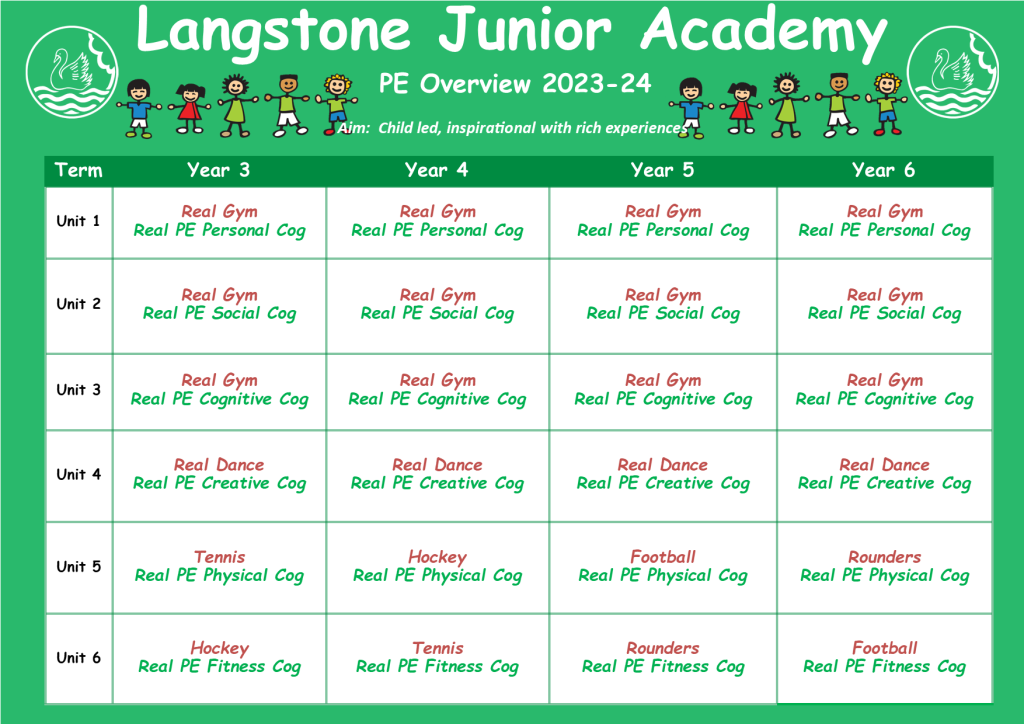Physical Education Intent
As part of our skills based PE curriculum, children will receive two one hour slots per week .
The lessons will focus on the skills needed to be successful when participating in physical activity as a whole and enabling them to live long healthy lives. The class teachers will use the strategies used in Real PE and Real Gym.
What is Real PE?
Real PE is a PE curriculum philosophy and approach which helps ALL children develop the physical literacy, emotional and thinking skills to achieve in PE, sport and life. It places the learner at the heart of practice with the ultimate goal of transforming how we teach PE, applying all of the high quality learning and teaching skills that have become the norm in other subjects.
What is Real Gym?
Real Gym is an innovative approach to support teachers to deliver high quality gymnastics in school and create rounded learners. This vibrant programme develops Fundamental Movement Skills (FMS) via gymnastic activities providing children with a springboard for future opportunities.
What else does the curriculum cover?
Within this skills based curriculum, pupils will be able to learn key movements to various dances and combine these to create their own routines. Children in Year 4 will be able to take part in swimming lessons to ensure they can be water safe. The curriculum also includes more traditional sports such as football, hockey, tennis and rounders in the summer months.
Clubs:
We will be offering clubs every Monday, Wednesday and Friday between 3:20 and 4:15. These clubs will consist of a variety of different events where children will be able to take part in a variety of fun activities ran by members of the Langstone Junior Academy teaching community.
PE lessons should be driven by the aims…
- To inspire pupils to participate in a range of physical activities.
- Provide opportunities for pupils to become physically confident in a way which supports their health and wellbeing.
- To learn use and apply new physical skills in a variety of different ways, becoming physically adaptable.
- Build respectful, resilient characters that are adaptable and agile to change.
- Children should be given the opportunity to evaluate and recognise their own success and identify their next steps.
With this in mind, we have developed three main aims that demonstrate the focus for our school:
- Increase the profile of PE and physical activities within the school as a vessel and tool for whole school improvement by increasing the confidence, knowledge and skills of all staff in teaching PE.
Because in order to pass on a love of being physically active, the staff must be equipped with the tools, mind-set, enthusiasm and knowledge to do so.
In order to increase the cultural capital of our pupils we will:
- Increase the engagement and broaden horizons of all pupils in regular physical activity, kick-starting healthy active bodies and minds.
Because we want to encourage lifelong active learners who have the tools and understanding to care for their own bodies.
- Increase opportunities for both inter and intra competition.
Because we believe it is fundamental to help our pupils become physically literate, build character and develop social skills, core values and beliefs which will lead to children becoming life-long active members of society.
In learning, this will mean that by the end of Key Stage 2, children will be equipped with the practical skills and knowledge in order to participate and compete in physical activities and lead a lifelong healthy lifestyle.
Children will be able to:
- Effectively transfer skills and movements across a range of activities and sports. They will also be able to perform a variety of skills consistently and effectively in challenging or competitive situations. (Physical).
- Give and receive sensitive feedback to improve themselves and others. They can also involve others, motivate those around them to perform better and collaborate appropriately. (Social).
- Review, analyse and evaluate their own and others’ strengths and weaknesses and can read and react to different game situations as they develop. (Cognitive).
- Respond imaginatively to different situations, adapting and adjusting their skills, movements or tactics so they are different from or in contrast to others. (Creative).
- See all new challenges as opportunities to learn and develop. They will also be able to recognize their strengths and weaknesses and can set themselves appropriate targets. (Personal).
- Describe the basic fitness components and explain how often and how long they should exercise to be healthy. They can also can self-select and perform appropriate warm up/cool down activities and can identify possible dangers when planning an activity. (Health and Fitness).



